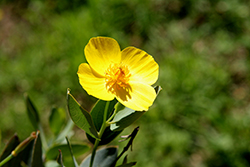It's all about ...
plants

Height: 10 feet
Spread: 8 feet
Sunlight:
![]()
Hardiness Zone: 8a
Other Names: California Bush Poppy, Tree Poppy
Description:
A wonderful evergreen shrub clothed with blue-green foliage, and is covered by large, brilliant yellow, cup shaped flowers from spring through summer; drought tolerant once established; a perfect accent shrub, or massed along borders
Ornamental Features
Bush Poppy features showy lightly-scented yellow cup-shaped flowers with gold eyes at the ends of the branches from mid spring to mid summer. It has bluish-green foliage with hints of gray. The pointy leaves remain bluish-green throughout the winter.
Landscape Attributes
Bush Poppy is a multi-stemmed evergreen shrub with an upright spreading habit of growth. Its average texture blends into the landscape, but can be balanced by one or two finer or coarser trees or shrubs for an effective composition.
This is a relatively low maintenance shrub, and should only be pruned after flowering to avoid removing any of the current season's flowers. It is a good choice for attracting butterflies to your yard. It has no significant negative characteristics.
Bush Poppy is recommended for the following landscape applications;
- Accent
- Mass Planting
- General Garden Use
- Naturalizing And Woodland Gardens
Planting & Growing
Bush Poppy will grow to be about 10 feet tall at maturity, with a spread of 8 feet. It has a low canopy, and is suitable for planting under power lines. It grows at a medium rate, and under ideal conditions can be expected to live for 40 years or more.
This shrub should only be grown in full sunlight. It is very adaptable to both dry and moist growing conditions, but will not tolerate any standing water. It is considered to be drought-tolerant, and thus makes an ideal choice for xeriscaping or the moisture-conserving landscape. As a rule, this plant should never be fertilized. It is not particular as to soil pH, but grows best in clay soils, and is able to handle environmental salt. It is somewhat tolerant of urban pollution. This species is native to parts of North America..
This plant is not reliably hardy in our region, and certain restrictions may apply; contact the store for more information.
